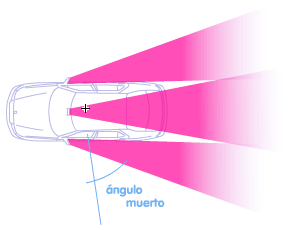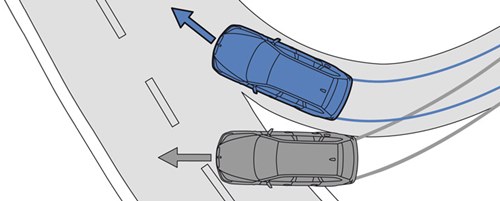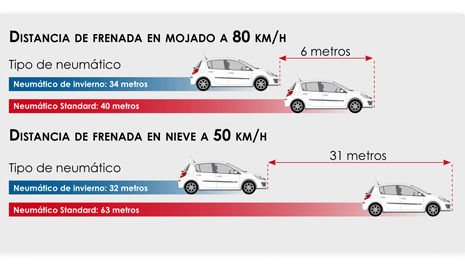Chapter 12: Visibility and Road Hazards
第 12 章:能见度和道路危险
12.1 Visibility 12.1 可见度
Demister device: a device that de-fogs the glass through hot jets of air.
除雾装置:通过热气流为玻璃除雾的装置。
Anti-frost device: filaments in the glass that heat slightly and de-fog the glass or prevents ice from forming.
防霜冻装置:玻璃中的丝状物会微微发热,消除玻璃上的雾气或防止结冰。
Mirrors 镜子
Mandatory mirrors are the exterior Left-hand side and rear-view inside mirrors. If this requirement is not met (e.g. if blinds or tinted glass are used and you cannot see in the interior mirror), the outside LEFT and RIGHT exterior mirrors are mandatory.
必须使用的后视镜是左侧车外后视镜和后视车内后视镜。如果不符合这一要求(例如,如果使用百叶窗或有色玻璃,则无法看到车内后视镜),则必须使用左侧和右侧车外后视镜。
A rear-view interior panoramic mirror does not replace any mandatory mirror.
后视车内全景后视镜不能取代任何强制性后视镜。
To adjust the mirror, the vehicle must be immobilized on a flat, horizontal place. Even if mirrors are properly adjusted, there is always an area that you cannot see because of the body, called the blind spot.
要调整后视镜,必须将车辆固定在平坦、水平的地方。即使正确调整了后视镜,由于车身的原因,总有一个区域是您看不到的,这就是盲区。

You should look in the mirrors briefly several times.
您应该对着镜子简单地照几次。
- Every 5-10 seconds on urban roads or inter-urban roads with heavy traffic
在交通繁忙的城市道路或城际道路上,每 5-10 秒钟一次 - Every 10-15 seconds on inter-urban roads in general
在一般城市间道路上,每 10-15 秒就会发生一次
 The exterior mirrors are convex and the vehicle behind you appears smaller and further away. To be well-adjusted, you should be able to see a bit of the back of the vehicle, NOT the side.
The exterior mirrors are convex and the vehicle behind you appears smaller and further away. To be well-adjusted, you should be able to see a bit of the back of the vehicle, NOT the side.
车外后视镜是凸面的,后面的车辆看起来更小、更远。要调整得当,您应该能够看到车辆的后部,而不是侧面。
The rear-view interior mirror is flat and for it to be well adjusted, you must be able to see 3 or 4 sides of the rear window.
后视内镜是平面的,要想调整好,必须能看到后窗的 3 或 4 个面。
Windscreen wipers 挡风玻璃雨刷器
Always use the slowest possible speed.
始终使用尽可能慢的速度。
12.2 Hazards on the road
12.2 道路上的危险
Night driving: 夜间驾驶
- Adapt speed to the area illuminated by the lights of your vehicle.
根据车灯照亮的区域调整车速。 - Avoid glare (slow speed, even coming to a stop).
避免眩光(放慢车速,甚至停车)。 - Use regulated and clean headlights.
使用规范、清洁的车头灯。
Bends: 弯曲:
- Avoid veering out of the bend (centrifugal force), causes: High speed, heavy load, tight bends.
避免偏离弯道(离心力),原因:高速、重载、狭窄弯道。 - Before entering: Slow down. While in the bend: Accelerate smoothly.
进入前减速在弯道中平稳加速。

An example of centrifugal force would be clothes spinning in a washing machine, which stick to the outside because of the force of the rotation.
离心力的一个例子就是在洗衣机中旋转的衣服,由于旋转的力量,衣服会粘在外面。
Rain: 雨
- Reduce speed 降低速度
- + Front distance and braking distance (double)
+ 前端距离和制动距离(双倍) - - Traction and visibility. Use appropriate lighting
- 牵引力和能见度。使用适当的照明 - Hazards: hydroplaning, check brakes, don’t splash, fogging windows
危险:水上滑行、检查刹车、不要溅水、车窗起雾 - You should be most cautious when the rain first starts
雨刚开始下的时候,您应该格外小心
Snow: 雪
- Reduce speed 降低速度
- + Front distance and braking distance
+ 前端距离和制动距离 - - Traction and visibility
- 牵引力和能见度 - Use chains or other approved devices. Chains are used at least on the drive wheels, recommended to use high gear and have a full tank.
使用链条或其他经批准的装置。至少在驱动轮上使用链条,建议使用高挡并加满油。 - It is advisable to drive in the tracks from other vehicles, as this will increase adhesion.
建议在其他车辆的轨道上行驶,这样会增加附着力。

BREAKING DISTANCE IN THE WET AT 80KPH
在湿滑路面上以 80 公里/小时的速度行驶时的断裂距离
- WINTER TYRE: 34m 冬季轮胎:34 米
- STANDARD TYRE: 40m 标准轮胎:40 米
BREAKING DISTANCE IN SNOW AT 50KPH
在雪地上以 50 公里/小时的速度行驶
- WINTER TYRE: 32m 冬季轮胎:32 米
- STANDARD TYRE: 63m 标准轮胎:63 米
Fog: 雾
- Reduce speed 降低速度
- + Front distance and braking distance
+ 前端距离和制动距离 - - Traction and visibility
- 牵引力和能见度 - Use proper lighting (do not use high beams)
使用适当的照明(不要使用远光灯) - Hazards: chain collisions, recommended to guide yourself by road markings
危险:连环相撞,建议根据路标指引方向
Ice: 冰
- Reduce speed 降低速度
- + Front distance and braking distance (by 10 times)
+ 前车距离和制动距离(10 倍) - - Traction and visibility
- 牵引力和能见度 - Hazards: use chains or other approved devices. Chains are used at least on the drive wheels, use caution at dawn and at night. In case of snow, you can use tires with studs or M&S
危险:使用链条或其他经批准的装置。至少在驱动轮上使用防滑链,黎明和夜间应谨慎使用。下雪时,可使用带钉轮胎或 M&S
Heat: 热
- + Reaction time + 反应时间
- + Fatigue (recommendable to take more breaks)
+ 疲劳(建议增加休息时间) - + Aggressiveness + 攻击性
- Sun: Wear sunglasses, clean the windows
太阳戴太阳镜,擦窗户
Smoke: Same as fog. 烟雾:与雾相同。
Wind (Cross winds): More dangerous from the side (lateral winds) and with gusts of wind. Dangerous to overtake a large vehicle, or at the intersection with another vehicle. Motorcycles and mopeds are the most affected by lateral winds.
风(横风):从侧面(横向风)和有阵风时更危险。超越大型车辆或在交叉路口与另一辆车相撞时很危险。摩托车和轻便摩托车受横向风的影响最大。




